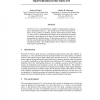Free Online Productivity Tools
i2Speak
i2Symbol
i2OCR
iTex2Img
iWeb2Print
iWeb2Shot
i2Type
iPdf2Split
iPdf2Merge
i2Bopomofo
i2Arabic
i2Style
i2Image
i2PDF
iLatex2Rtf
Sci2ools
NIPS
2003
2003
A Probabilistic Model of Auditory Space Representation in the Barn Owl
The barn owl is a nocturnal hunter, capable of capturing prey using auditory information alone [1]. The neural basis for this localization behavior is the existence of auditory neurons with spatial receptive fields [2]. We provide a mathematical description of the operations performed on auditory input signals by the barn owl that facilitate the creation of a representation of auditory space. To develop our model, we first formulate the sound localization problem solved by the barn owl as a statistical estimation problem. The implementation of the solution is constrained by the known neurobiology.
| Added | 31 Oct 2010 |
| Updated | 31 Oct 2010 |
| Type | Conference |
| Year | 2003 |
| Where | NIPS |
| Authors | Brian J. Fischer, Charles H. Anderson |
Comments (0)

